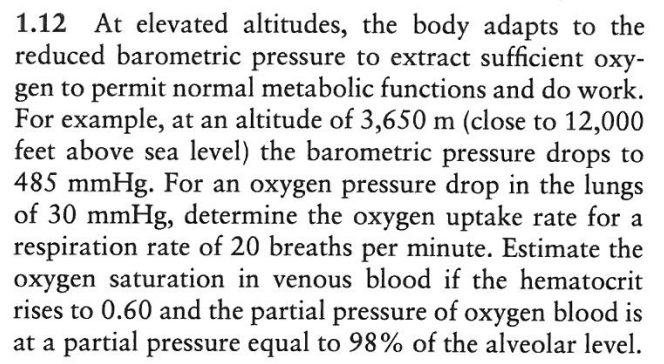1.12 At elevated altitudes, the body adapts to the reduced barometric pressure to extract sufficient oxy- gen to permit normal metabolic functions and do work. For example, at an altitude of 3,650 m (close to 12,000 feet above sea level) the barometric pressure drops to 485 mmHg. For an oxygen pressure drop in the lungs of 30 mmHg, determine the oxygen uptake rate for a respiration rate of 20 breaths per minute. Estimate the oxygen saturation in venous blood if the hematocrit rises to 0.60 and the partial pressure of oxygen blood is at a partial pressure equal to 98% of the alveolar level.
1.12 At elevated altitudes, the body adapts to the reduced barometric pressure to extract sufficient oxy- gen to permit normal metabolic functions and do work. For example, at an altitude of 3,650 m (close to 12,000 feet above sea level) the barometric pressure drops to 485 mmHg. For an oxygen pressure drop in the lungs of 30 mmHg, determine the oxygen uptake rate for a respiration rate of 20 breaths per minute. Estimate the oxygen saturation in venous blood if the hematocrit rises to 0.60 and the partial pressure of oxygen blood is at a partial pressure equal to 98% of the alveolar level.
Biology: The Dynamic Science (MindTap Course List)
4th Edition
ISBN:9781305389892
Author:Peter J. Russell, Paul E. Hertz, Beverly McMillan
Publisher:Peter J. Russell, Paul E. Hertz, Beverly McMillan
Chapter7: Cellular Respiration: Harvesting Chemical Energy
Section: Chapter Questions
Problem 13TYK: 13. There are several ways to measure cellular respiration experimentally. For example, CO2 and...
Related questions
Question

Transcribed Image Text:1.12 At elevated altitudes, the body adapts to the
reduced barometric pressure to extract sufficient oxy-
gen to permit normal metabolic functions and do work.
For example, at an altitude of 3,650 m (close to 12,000
feet above sea level) the barometric pressure drops to
485 mmHg. For an oxygen pressure drop in the lungs
of 30 mmHg, determine the oxygen uptake rate for a
respiration rate of 20 breaths per minute. Estimate the
oxygen saturation in venous blood if the hematocrit
rises to 0.60 and the partial pressure of oxygen blood is
at a partial pressure equal to 98% of the alveolar level.
Expert Solution
This question has been solved!
Explore an expertly crafted, step-by-step solution for a thorough understanding of key concepts.
This is a popular solution!
Trending now
This is a popular solution!
Step by step
Solved in 3 steps

Recommended textbooks for you

Biology: The Dynamic Science (MindTap Course List)
Biology
ISBN:
9781305389892
Author:
Peter J. Russell, Paul E. Hertz, Beverly McMillan
Publisher:
Cengage Learning

Human Physiology: From Cells to Systems (MindTap …
Biology
ISBN:
9781285866932
Author:
Lauralee Sherwood
Publisher:
Cengage Learning

Biochemistry
Biochemistry
ISBN:
9781305577206
Author:
Reginald H. Garrett, Charles M. Grisham
Publisher:
Cengage Learning

Biology: The Dynamic Science (MindTap Course List)
Biology
ISBN:
9781305389892
Author:
Peter J. Russell, Paul E. Hertz, Beverly McMillan
Publisher:
Cengage Learning

Human Physiology: From Cells to Systems (MindTap …
Biology
ISBN:
9781285866932
Author:
Lauralee Sherwood
Publisher:
Cengage Learning

Biochemistry
Biochemistry
ISBN:
9781305577206
Author:
Reginald H. Garrett, Charles M. Grisham
Publisher:
Cengage Learning

Anatomy & Physiology
Biology
ISBN:
9781938168130
Author:
Kelly A. Young, James A. Wise, Peter DeSaix, Dean H. Kruse, Brandon Poe, Eddie Johnson, Jody E. Johnson, Oksana Korol, J. Gordon Betts, Mark Womble
Publisher:
OpenStax College